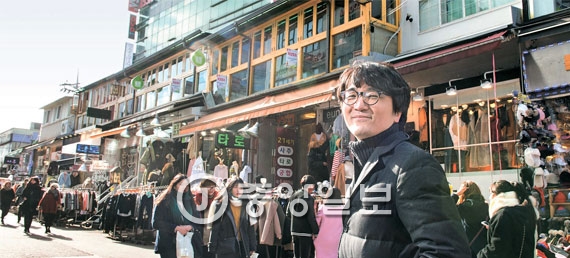Exploring Seoul’s past through its architecture

Jo Han, a professor of architecture at Hongik University, stands at Seogyo-365, a popular area in front of the university. “The coexistence of the traditional and the modern defines the true beauty of Seoul,” he says. [OH SANG-MIN]
Born in Mia-dong in Gangbuk District, northern Seoul, in 1960, Jo grew up in Apgujeong-dong in Gangnam District, southern Seoul, in the 1970s. He attended Hongik University from the ’80s to ’90s. His tours are explorations of the city he grew up in and the changes he personally witnessed. Take his description of the Express Bus Terminal in Seocho District, southern Seoul.
“The terminal was originally intended to give off the vibe of a ‘vertical city’ but was stunted due to a lack of technical skills [in the country],” the 48-year-old professor explains. “The terminal had gates on the third, fourth and fifth floors of the building in the ‘80s, and theaters and even a wedding hall filled the spaces up to the 11th floor.”
The bus station and its ambitions reflected the national pride prevalent in the ‘80s with the economic boom and the 1988 Seoul Summer Olympics.
“But hasty architectural development revealed its shortcomings with the collapse of the Seongsu Bridge in 1994 and Sampoong Department Store in 1995. That’s when the Express Bus Terminal closed down its gates from the third to fifth floors.
“The terminal is a true embodiment of South Korea as a developing nation, when it had a can-do spirit but lacked social and technical infrastructure,” Jo says.
His tours are called “Reading Seoul Through its Alleyways” and “Train Tracks of Time.” He takes his groups off the beaten track to areas like Seogyo-365, a famous address in Seogyo-dong in Mapo District, western Seoul. Visitors are brought there to see houses built over railroad tracks that used to deliver coal from the 1920s to ‘70s.
Jo leads his custom architectural tours of Seoul from March to April and September to October. The places he has discovered in Seoul are described in his book “Seoul, the Memory of the Place and a Place to Remember.”
“The charm of Seoul is not in the city’s tallest buildings,” Jo says. “That’s for cities like New York or Dubai. Seoul exhibits what the rest of the world cannot - a spurt of growth over a short period of time.
“The traditional and the modern coexist in this city. I hope the rest of the world can see Seoul’s beauty as well.”
BY YOON SEOK-MAN, KIM NA-HAN [chung.juhee@joongang.co.kr]










with the Korea JoongAng Daily
To write comments, please log in to one of the accounts.
Standards Board Policy (0/250자)